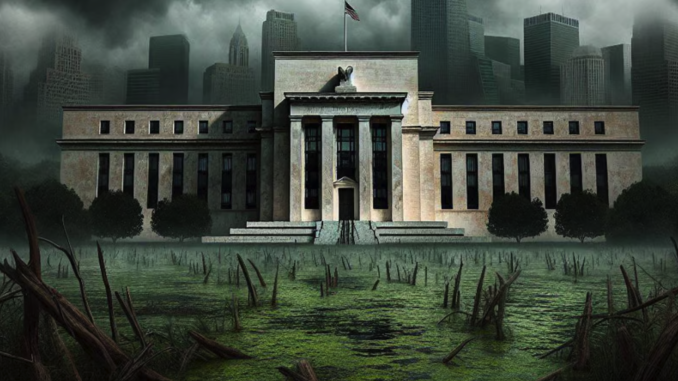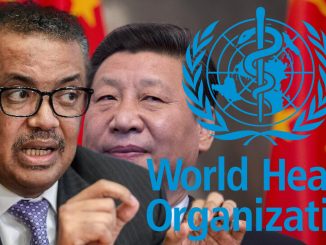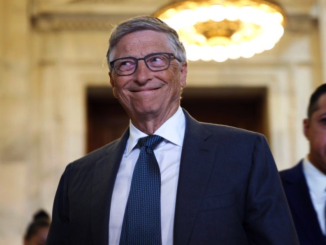
Original Article by Ryan McMaken
For decades, the US Federal Reserve has carefully cultivated and promoted the idea that it is somehow separate and independent from the US regime that created it. IT’S NOT.
The ruse has certainly worked. Economists and media pundits frequently refer to this alleged Fed “independence” as if it were a given, and as if there were a wall of separation between the executive branch and the central bank. Others take it even further, and in podcasts and social media one encounters a variety of crackpot theories asserting that the Fed is somehow at odds with the regime, or that the Fed answers only to bankers without regard for the regime’s agenda.
Some of those who have been hoodwinked by the Fed-independence myth will, at times, even claim that the Fed is some kind of benevolent fifth column that’s trying to undermine federal fiscal profligacy and save the dollar from tax-and-spend politicians.
Yes, the senior technocrats at the Fed don’t always agree with Congressional or White House priorities, but the same could be said of diplomats at the State Department. Few would claim, however, that disagreement means there is “State-Department independence.”
Indeed, its true that bureaucrats generally prefer to do their own thing without having to get approval from the higher-ups. In this respect, Fed personnel are no different from senior technocrats at any executive-branch department. In practice, however, historical experience shows that, time and again, the Federal Reserve has “coordinated” its policies with those of the Treasury and the administration to ensure that the federal government gets exactly what it wants from the central bank.
Keeping the War Machine Going
During the great Depression and the Second World War, for example, the executive branch under Franklin Roosevelt overtly managed the Federal Reserve and required the Fed’s close cooperation with the White House. During this period, the Fed had attempted to gain more autonomy, but only ostensibly succeeded in doing so with a 1935 amendment to the Federal Reserve Act. These timid efforts at independence were cut short by the onset of the Second World War. According to a report from the Richmond Fed,
When the United States entered World War II, the Fed became again a mechanism by which the government could more cheaply finance the war effort. In April 1942, the Fed announced a policy of cooperating with the Treasury to keep interest rates low. By 1947, the Fed was summarizing its “primary duty” as “the financing of military requirements and of production for war purposes.” In his memoirs, [Fed Chairman Marriner] Eccles even described his work during this period as “a routine administrative job” as the Fed “merely executed Treasury decisions.” Alan Sproul, the president of the New York Fed, lamented, “We are not the masters in our own house.”
During this period, the Fed was called upon to perform the primary function of all central banks: help the regime finance war debts. The Fed was directed by the White House to intervene and purchase Treasurys whenever necessary to keep yields below a certain level. As Fed historian Allan Meltzer puts it: “the Federal Reserve’s role was to prevent the market from failing to accept a Treasury issue; in practice that meant it supplied enough reserves to keep interest rates from rising around the time the Treasury sold its offering.”1
Into the 1950s, the union between the Fed and the rest of the executive branch was explicit in legislation. During the Korean war, however, the Fed attempted to attain greater independence, and thanks to the end of the war and the return to more sedate levels of federal spending, it appeared to some this might actually be possible.
Yet, the needs of Cold War spending and new welfare programs quickly brought the true reality into view.
The Great Inflation and the 1970s
Fed Chairman William McChesney Martin is known for supposedly “taking away the punch bowl” during times of economic boom in order to tamp down price inflation. That may have been Martin’s preference, but as federal spending accelerated during the 1960s, the Treasury increasingly called upon the Fed to enable larger deficits without allowing Treasury yields to rise. The “guns and butter” policies of the Great Society and the Vietnam War meant the Fed would have to work closely with the Treasury to get the executive branch the deficit funding it wanted.
This policy came to be called “coordination.” As Meltzer puts it, Martin “agreed that the Federal Reserve should assist in financing the deficit because Congress approved it. Thus, he accepted ‘coordination.’”2 By 1974, though, a debate remained as to how much the Fed should do this. Or, as stated in FOMC minutes from March 1974: “While the Federal Reserve would always accommodate the Treasury up to a point, the charge could be made—and was being made—that the System had accommodated the Treasury to an excessive degree.”3
There is no clear position on what constitutes “excessive,” of course. This is decided not by any objective or scientific standard, but simply by the political needs of the regime.
It was this “coordination,” that led to the Great Inflation—by which is meant price inflation—of the late 1960s and the 1970s. As annual federal deficits more than doubled from $10 billion to $25 billion each year in the second half of the decade, the new Fed Chairman Arthur Burns was clearly more than willing to do what it took to ensure that that there was plenty of “coordination” between the Treasury and the Fed in order to achieve political ends. In practice, this meant that the Burns Fed was unwilling to rein in price inflation. As Meltzer sums it up:
The Great Inflation resulted from policy choices that placed much more weight on maintaining high or full employment than on preventing or reducing inflation. For much of the period, this choice reflected both political pressures and popular opinion expressed in the polls.4
The Plaza Accords: Volcker Embraces a Weak Dollar
By the early 1980s, price inflation itself had become enough of a political problem to force the new Reagan administration to request that the Fed—then led by Paul Volcker—abandon its usual policy of ongoing interventions to suppress borrowing costs for the Treasury. The result was a rapid increase in Treasury yields, but also led to a significant decline in price inflation.
This turn toward hawkish monetary policy would only last a few years, however. A side effect of this pivot in monetary monetary policy was a stronger dollar—especially relative to the yen—which made American exports more expensive and fueled a larger trade deficit.
Special interest groups soon began to demand a weaker dollar. Some within the Reagan administration were happy to oblige and Treasury secretary James Baker “recognized and wanted to respond to the political pressures from manufacturers, farmers, and especially members of Congress. Exporting manufacturers complained about the value of the dollar that, they said, made it difficult for them to compete.”5 In the words of economist Brendan Brown, the strong dollar “caused a surge of protectionism.”6
So, administration officials began negotiations in 1985—resulting in the so-called Plaza Accord—during which “five finance ministers and central bank governors agreed to attempt an orderly depreciation of the dollar.”7 This happened on Volcker’s watch, and it should be noted that, in spite of his modern and undeserved reputation as a doctrinaire “hard money” man, Volcker’s acquiescence to the Plaza devaluation was not surprising. As Brown reminds us, Volcker
had never changed his spots from his days as the devaluation diplomat when he served as under-secretary of the Treasury in the Nixon Administration. … He joined in the new dollar devaluation campaign, easing monetary policy ostensibly in response to the economic slowing but also in effect a key component of the Plaza Accord…8
Through it all, the Fed remained ever at the side of the administration, ready to “assist” the Treasury and the administration with coordinated monetary policy.
After the Global Financial Crisis
Since the 2008 financial crisis, the Fed’s enthusiastic willingness to coordinate with the Treasury and the Congress has become all the more apparent and undeniable. Deficits mounted and the federal debt rose by more than five trillion dollars from 2008 to 2011. Consequently, the spirit of the 1940s had returned at the Fed as the central bank bought up trillions of dollars of Treasurys—with printed money—to force down federal borrowing costs. The Fed embraced zero-interest rate-policy for an astonishing eight years, and in spite of seemingly endless proclamations of economic strength, the Fed refused to allow the target interest rate to rise. The Fed also refused to sell off substantial portions of the Fed’s portfolio. As with the lead up to the Great Inflation, the Fed had again decided to serve the political needs of the federal government, choosing employment maximization and adopting an arbitrary new “two-percent target” allowing greater political flexibility for incessant price inflation.
Although it had promised to “unwind” its inflationary asset purchases in the several years following the 2008 crisis, the Fed never did so. So, when the 2020 Covid Panic arrived, the Fed needed no change of direction, but only had to accelerate its existing policies. From 2020 to 2022, the Fed bought up an additional three trillion in Treasurys with printed money reflecting its political commitment to facilitate new unprecedented levels of peacetime deficit spending. Even the Fed describes this political arrangement as an echo of earlier wartime political arrangements. According to a 2021 report from the Atlanta Fed, the Fed’s covid policy was similar to that of the Fed’s policies of the Second World War in that it was “a big increase in government debt accommodated by Fed bond purchases under an explicit commitment to keep interest rates at very low levels.” Naturally, federal deficits and debt skyrocketed after 2020 and has never returned to pre-covid levels.
Given this long history of enabling the federal government’s gargantuan debts and runaway spending, its difficult to see where the legendary “Fed independence” fits into all of this. Rather, an honest look at Fed interventions suggests that the Fed never refuses to facilitate the federal executive branch in implementing its political program. Yet, even today, some more credulous observers still believe that the Fed is fighting the administration in the name of “fiscal responsibility.”
These fantasies notwithstanding, the Fed has never done this, and the Fed is not doing it now. It means nothing at all that that Jerome Powell in recent months has made some scornful-sounding remarks about how the Congress needs to get its fiscal house together. What matters is what the Fed does, not what the Fed says. History has shown us that when the Treasury needs help with some new political scheme—such as inflating bond prices or blowing up anew employment bubble—the Fed will give the Treasury what it wants.
It’s all been a charade to get the people to look over there – when the actions they take are moving OVER THERE!




